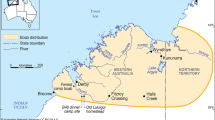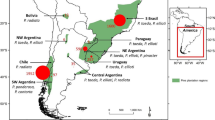Abstract
Tree-ring analyses of 23 bark-stripped trees, mostly Thuja plicata (western red cedar) but also Chamaecyparis nootkatensis (yellow cedar) and Picea sitchensis (Sitka spruce), help describe traditional Native tree-bark exploitation at a site north of Ketchikan in southeast Alaska, USA. Tree-ring samples exposed 36 cultural scars dating from between a.d. 1718 and 1912, showing that Natives landed on this hazardous stretch of Clarence Strait to take tree bark in 29 (about 15%) of the 195 years spanned by the sample. One-third of these culturally modified trees had multiple scars indicating repeated use of individual trees. The most intensive forest use occurred between 1852 and 1895, while the lack of bark scars after 1912 marks a decline in traditional Native craft. A burst of bark-stripping between 1779 and 1787 may be associated with the legendary last battle between the Stikine Tlingit of Alaska and the Tsimshian of British Columbia. The sample is compared with dated samples from British Columbia (Canada) and Washington State, USA.





Similar content being viewed by others
References
Arcas Associates (1984) Meares Island aboriginal tree utilization study. Report Arcas Associates Heritage Resource Consultants for MacMillan Bloedel Ltd, Nanaimo
Bergman I, Östlund L, Zackrisson O (2004) The use of plants as regular food in ancient subarctic economies: a case study based on Sami use of Scots pine innerbark. Arctic Anthropol 41:1–13
Eldridge A, Eldridge M (1986) Dendrochronology of CMTs in Block 57A, Lyell Island. BC Report Eldridge Heritage Consulting, Victoria
Ericsson TS, Östlund L, Andersson R (2003) Destroying a path to the past—the loss of culturally scarred trees and change in forest structure along Allmunvagen, in mid-west boreal Sweden. Silva Fennica 37:283–298
Goldschmidt WR, Haas TH (1998) Haa Aani, our land: Tlingit and Haida land rights and use. Sealaska Heritage Foundation, Juneau
Gottesfeld LMJ (1992) The importance of bark products in the aboriginal economics of Northwestern British Columbia, Canada. Econ Bot 46:148–157
Hicks R (1985) Culturally altered trees: a data source. Northwest Anthropol Res Notes 19:100–118
Kaye MW, Swetnam TW (1999) An assessment of fire, climate, and Apache history in the Sacramento Mountains, New Mexico, USA. Physical Geogr 20:305–330
Lewis M, Mobley CM (1994) Culturally modified trees at Bartlett Cove, Glacier Bay National Park, Alaska. Report Charles M. Mobley & Associates for National Park Service Alaska District, Anchorage
Mack CA (1996) A summary of archaeological data recovery at twenty-four culturally modified tree sites on the Gifford Pinchot National Forest. USDA Forest Service—Pacific Northwest Region, Gifford Pinchot National Forest, Mt. Adams Ranger District
Mack CA, Hollenbeck BJ (1985) Peeled cedar management plan. Manuscript on file, Gifford Pinchot National Forest, Pacific Northwest Region, USDA Forest Service, Vancouver, WA
Mobley CM (1984) An archaeological survey of 15 timber harvest units at Naukati Bay on Prince of Wales Island, Tongass National Forest, Alaska. Report Charles M. Mobley for USDA Forest Service, Ketchikan
Mobley CM (1989) An archaeological survey on the Cleveland Peninsula, Southeastern Alaska, including 6 timber harvest units. Report Charles M. Mobley for USDA Forest Service, Ketchikan
Mobley CM (2002) Yatuk Creek Block archaeological survey, Prince of Wales Island, Southeast Alaska. Report Charles M. Mobley & Associates for Alaska Division of Forestry, Ketchikan
Mobley CM, Eldridge M (1992) Culturally modified trees in the Pacific Northwest. Arctic Anthropol 29:91–110
Niklasson M, Zackrisson O, Östlund L (1994) A dendroecological reconstruction of use by Saami of Scots pine (Pinus sylvestris L.) inner bark over the last 350 years at Sadvajaure, N. Sweden. Veget Hist Archaeobot 3:183–190
Östlund L, Tysk O, Hornberg G (2003) Traces of past Saami forest use: an ecological study of culturally modified trees and earlier land use within a boreal forest reserve. Scand J Forest Res 18:78–98
Prince P (2001) Dating and interpreting pine cambium collection scars from two parts of the Nechako River drainage, British Columbia. J Archaeol Sci 28:253–263
Steward H (1984) Culturally modified trees. Midden 16:7–9
Stryd AH, Eldridge M (1993) CMT archaeology in British Columbia: the Meares Island studies. BC Studies 99:184–234
Swetnam TW (1984) Peeled ponderosa pine trees: a record of inner bark utilization by native Americans. J Ethnobiol 4:177–190
Waterman TT (1922) Tlingit geographical names for extreme southeast Alaska: with historical and other notes. Bureau of American Ethnology manuscript file 2938. Smithsonian Institution, Washington, DC
Zackrisson O, Östlund L, Korhonen O, Bergman I (2000) Ancient use of Scots pine inner bark by Sami in northern Sweden related to cultural and ecological factors. Veget Hist Archaeobot 9:99–109
Acknowledgments
The Ship Island research was funded by Alaska Humanities Forum Grant 36-96 and conducted with permission of the landowner, Sealaska Corporation. Boat transportation and a steady chain-saw hand were contributed by Jay Sipe of Ketchikan, Alaska. We’re grateful to those who have reviewed drafts of this paper.
Author information
Authors and Affiliations
Corresponding author
Additional information
Communicated by F. Bittmann.
Rights and permissions
About this article
Cite this article
Mobley, C.M., Lewis, M. Tree-ring analysis of traditional native bark-stripping at Ship Island, Southeast Alaska, USA. Veget Hist Archaeobot 18, 261–268 (2009). https://doi.org/10.1007/s00334-008-0204-4
Received:
Accepted:
Published:
Issue Date:
DOI: https://doi.org/10.1007/s00334-008-0204-4




